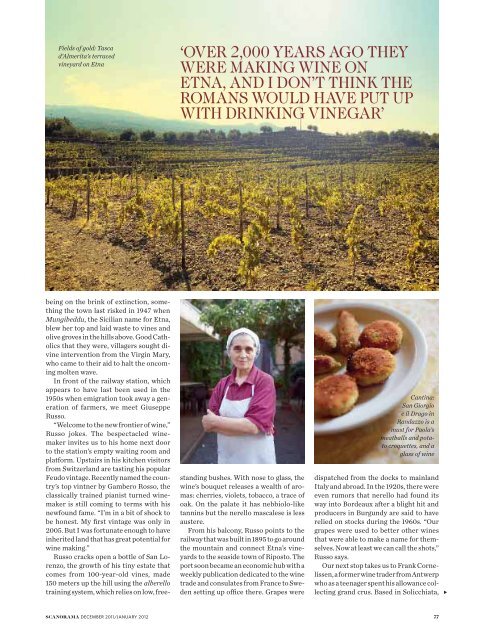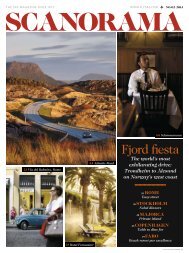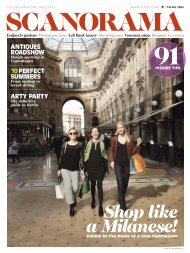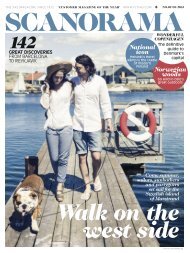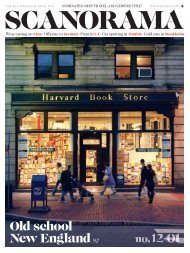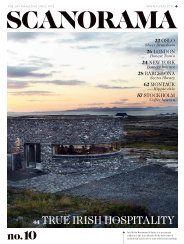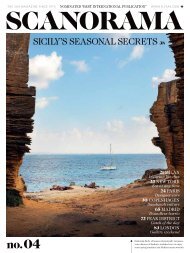Old school New England 92 - Scanorama
Old school New England 92 - Scanorama
Old school New England 92 - Scanorama
Create successful ePaper yourself
Turn your PDF publications into a flip-book with our unique Google optimized e-Paper software.
Fields of gold: Tasca<br />
d’Almerita’s terraced<br />
vineyard on Etna<br />
being on the brink of extinction, something<br />
the town last risked in 1947 when<br />
Mungibeddu, the Sicilian name for Etna,<br />
blew her top and laid waste to vines and<br />
olive groves in the hills above. Good Catholics<br />
that they were, villagers sought di -<br />
vine intervention from the Virgin Mary,<br />
who came to their aid to halt the oncoming<br />
molten wave.<br />
In front of the railway station, which<br />
appears to have last been used in the<br />
1950s when emigration took away a gen -<br />
eration of farmers, we meet Giuseppe<br />
Russo.<br />
“Welcome to the new frontier of wine,”<br />
Russo jokes. The bespectacled winemaker<br />
invites us to his home next door<br />
to the station’s empty waiting room and<br />
platform. Upstairs in his kitchen visitors<br />
from Switzerland are tasting his popular<br />
Feudo vintage. Recently named the country’s<br />
top vintner by Gambero Rosso, the<br />
classically trained pianist turned winemaker<br />
is still coming to terms with his<br />
newfound fame. “I’m in a bit of shock to<br />
be honest. My first vintage was only in<br />
2005. But I was fortunate enough to have<br />
inherited land that has great potential for<br />
wine making.”<br />
Russo cracks open a bottle of San Lo -<br />
renzo, the growth of his tiny estate that<br />
comes from 100-year-old vines, made<br />
150 meters up the hill using the alberello<br />
training system, which relies on low, free-<br />
‘OVER 2,000 YEARS AGO THEY<br />
WERE MAKING WINE ON<br />
ETNA, AND I DON’T THINK THE<br />
ROMANS WOULD HAVE PUT UP<br />
WITH DRINKING VINEGAR ’<br />
standing bushes. With nose to glass, the<br />
wine’s bouquet releases a wealth of aromas:<br />
cherries, violets, tobacco, a trace of<br />
oak. On the palate it has nebbiolo-like<br />
tannins but the nerello mascalese is less<br />
austere.<br />
From his balcony, Russo points to the<br />
railway that was built in 1895 to go around<br />
the mountain and connect Etna’s vineyards<br />
to the seaside town of Riposto. The<br />
port soon became an economic hub with a<br />
weekly publication dedicated to the wine<br />
trade and consulates from France to Sweden<br />
setting up office there. Grapes were<br />
Cantina:<br />
San Giorgio<br />
e il Drago in<br />
Randazzo is a<br />
must for Paola’s<br />
meatballs and potato<br />
croquettes, and a<br />
glass of wine<br />
dispatched from the docks to mainland<br />
Italy and abroad. In the 1<strong>92</strong>0s, there were<br />
even rumors that nerello had found its<br />
way into Bordeaux after a blight hit and<br />
producers in Burgundy are said to have<br />
relied on stocks during the 1960s. “Our<br />
grapes were used to better other wines<br />
that were able to make a name for themselves.<br />
Now at least we can call the shots,”<br />
Russo says.<br />
Our next stop takes us to Frank Cornelissen,<br />
a former wine trader from Ant werp<br />
who as a teenager spent his allowance collecting<br />
grand crus. Based in Solicchiata,<br />
SCANORAMA DECEMBER 2011/JANUARY 2012 77<br />
�


